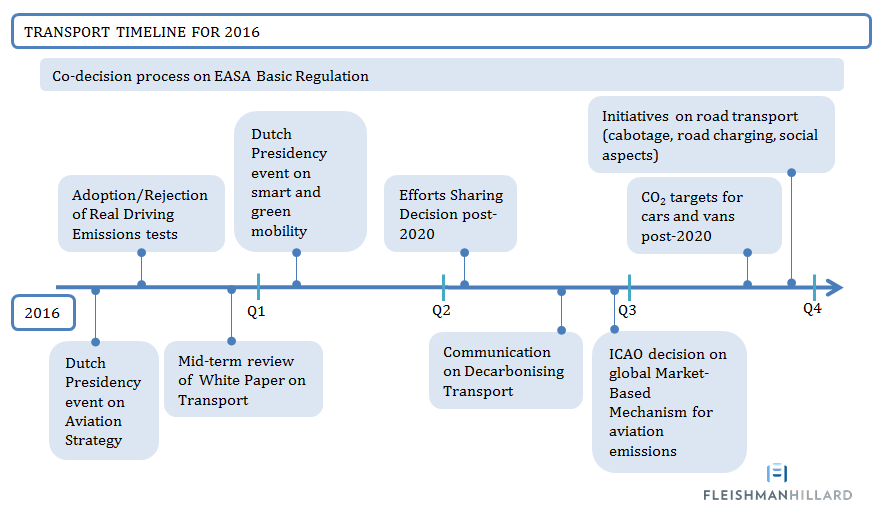How better to start a year full of transport policy initiatives than with some Dutch pragmatism? Transport is a practical sector itself as it inevitably links to one of the most basic needs of the economy: moving goods and people. 2016 looks to be an important year for transport and we have two keywords: competitiveness and sustainability.
In certain people’s eyes, the focus on these two main driving forces, competitiveness and sustainability, risks creating a significant dilemma: Should the EU try to boost competitiveness through a modern, innovative transport system or push for sustainability through unprecedented environmental policies and ambitious targets?
The Commission has to a large extent addressed the dilemma by betting on the leadership of Europe in the fight against climate change and the fact that the rest of the World will eventually follow, ultimately providing a competitive advantage for Europe. While this has not always proven to be true in the past, the agreement reached at the last UN Conference of Parties on Climate Change (COP21) may mean a step towards Europe’s ambitions with countries like the U.S. and China, which have insofar played the ‘competitiveness first’ card, committing to global environmental objectives.
What can we expect in the next months to reconcile these contradictory forces?
Competitiveness
The Netherlands EU Presidency kicks-off with a high-level conference at Schiphol airport today on the just-released EU Aviation Strategy. Coincidentally, Schiphol airport is celebrating its 100th anniversary this year …
Discussions on aviation have so far focused on alleged unfair competition from the non-EU airlines Beyond this populist debate, which seems to ignore what’s really needed in the European aviation sector, a serious rethink of the management of Europe’s strategic airports, a final solution for the capacity crunch and the completion of the Single European Sky are all long overdue.
The Commission is also looking at the competitiveness of the road transport sector and, despite the fact that the three initiatives on the social dimensions of transport, cabotage and road charging will not be grouped into a single legislative package, the Commission is addressing them simultaneously.
Several other initiatives are expected in the first half of the year including the mid-term review of the White Paper on transport, which touches on the competitiveness and also sustainability of the EU transport system. No major changes are expected in terms of long term objectives, but more emphasis will be put on the means to achieve them. The review will also probably sound the death knell of the modal shift approach, adopted in the 2009 White Paper, in favour of the more comprehensive concept of co-modality, which recognizes the need to use all the means of transport and for each one to achieve its best and most sustainable performances.
Sustainability
Talking about sustainability, another Presidency meeting will follow in April, to discuss smart and green mobility. No surprise, this meeting will touch on cycling as well as other types of active mobility. The Dutch aim to adopt the ‘Amsterdam Chapter’ on green and smart mobility, as mentioned by the Minister during the last Environmental Council of 2015. The Informal Transport Council will then follow in June, at the end of the Presidency.
Decarbonising transport is an important part of the Energy Union strategy, and a Communication is expected in the second half of the year. The Communication should be preceded by a new proposal for the continuation of the Effort Sharing Decision post-2020, which currently sets binding national targets for GHG emissions coming from agriculture, building, waste and indeed transport (excluding aviation and international maritime shipping).
More will come our way on CO2 emissions targets for both Heavy-Duty Vehicles (HDVs) and Light-Duty Vehicles (LDVs), such as cars and vans. The Commission started tackling HDVs emissions for the first time two years ago and is working on a new instrument which will help the monitoring process and hopefully lead to more informed choices from operators. On the LDVs side, post-2020 CO2 targets will have to be discussed after the modalities to achieve the current ones where agreed only in 2014. This debate has started prematurely due to the ‘dieselgate’ scandal which opened a Pandora’s box for emissions measurements performed by carmakers and authorised by national authorities. Some countries are undertaking initiatives to move away from diesel but will the scandal be the trigger for revamping the debate on energy taxation and the removal of the taxation advantage towards diesel in Europe?
Whilst everyone in Brussels is busy trying to minimize the negative spill-over effects of ‘dieselgate’ and to re-establish consumers’ trust in the automotive sector, DG CLIMA has gone through a major internal reorganisation with the ‘Transport and Ozone’ unit, which to-date dealt with transport emissions, being split into three units to reflect the non-ETS sectors (buildings, agriculture and transport). This means that all those affected by legislation on transport emissions may wish to get acquainted with the new “Mr Transport Emissions” in DG CLIMA.
By Laura Rozzo
3 Comments
Find Out More
-
Generative AI is changing the search game
May 8, 2025
-
The challenges facing Europe and European leaders at Davos 2025
January 24, 2025




March 10, 2016 | 9:39 PM
JOIN ILLUMINATI TO BE RICH AND FAMOUS. Email Now: [email protected] or call +2348070940793
January 20, 2016 | 1:13 PM
A rich agenda for transport in 2016: https://t.co/udlJAabUW0
January 20, 2016 | 12:06 PM
RT @fleishmanEU: A rich agenda for transport in 2016 https://t.co/i852IqbbmI